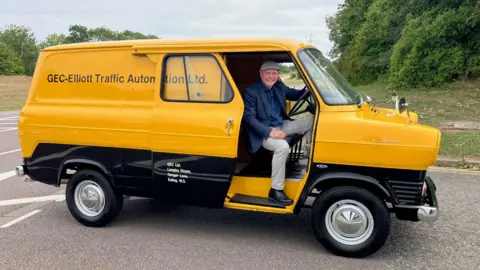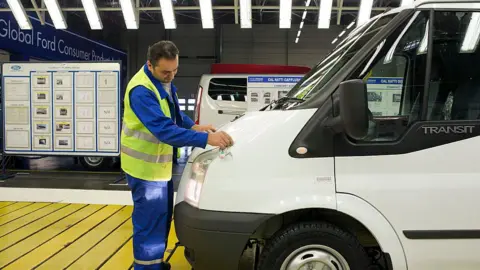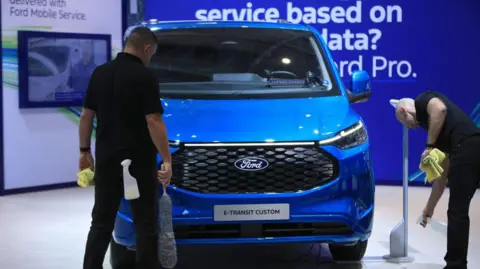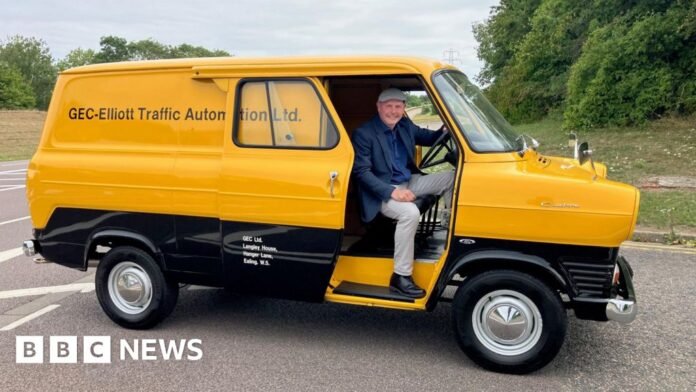International Business Correspondent
 BBC
BBCClimbing into a 1965 Ford Transit is like stepping into a time capsule on wheels.
Forget your modern high-tech nicknacks like satnavs and touchscreens. All you get here is a steering wheel, a big chrome-lined speedometer dial and a chunky heater control. There isn’t even a radio.
Out on the road, it rattles and bangs and occasionally jumps out of gear.
Disconcertingly, there’s no seatbelt, the seat itself has an alarming tendency to move around, and the brakes don’t seem to do very much at all.
Beautiful as it is, it’s hard to imagine that this elderly machine was ever state of the art.
Yet when the original Transit first rolled off the production line at Ford’s plant in Langley, Berkshire, on 9 August 1965, it was a revelation.
By the standards of the day, it was remarkably spacious, powerful and practical. It was comfortable, had sharp handling, and put existing vans such as the Morris J4 firmly in the shade.
Sixty years later, the Transit has been redesigned many times, but the brand itself is still going strong. It remains a staple for many small businesses, even in an age when “white vans” are ten a penny, and the market is rife with competition.
It is the world’s best-selling van – and more than 13 million have been built so far.
“There are lots of iconic cars: the Morris Minor, the Mini, the Land Rover, the VW Beetle, but there’s only one iconic van, and that’s the Transit,” says Edmund King, president of the AA.
“It’s probably the only van that people really know”.
 Erica Echenberg via Getty Images
Erica Echenberg via Getty ImagesOriginally a collaboration between Ford’s engineers in the UK and Germany, and primarily aimed at the British and European markets, the Transit was designed to be as versatile as possible.
It rapidly became a staple for tradespeople, including builders, carpenters, electricians and delivery drivers.
But it also appealed to others looking for spacious, cheap transport – including aspiring rock bands. It was almost a rite of passage. Among those who spent time on the road in one were Black Sabbath, Led Zeppelin, the Small Faces and Slade.
“It was the freedom to go where you want, when you want. Petrol was a lot cheaper than it is now,” says Peter Lee, founder of the Transit Van Club.
“I ended up in Spain, lived in one for 13 months as a hippy on a strawberry farm, then came back and started a business. Before you know it, I had 180 workers in 28 Transit vans driving around London.”
‘Britain’s most wanted van’
The Transit’s speed and loading space also appealed to people on the wrong side of the law.
In 1972, so the story goes, a Metropolitan Police spokesman claimed Transits were being used in 95% of bank raids, adding that its speed and loading space meant it had become the perfect getaway vehicle. This, he commented drily, made it “Britain’s most wanted van”.
Meanwhile the stereotype of the bullying “white van man”, defined by Sunday Times reporter Jonathan Leake in 1997 as “a tattooed species, often with a cigarette in his mouth, who is prone to flashing his lights as he descends on his prey”, did not specifically target Transit drivers.
But given how many of them were on the road by then, it is a fair bet they were implicated.
Made in Turkey
For nearly half a century, Transits were built in Britain – first at Langley, then at a factory just outside Southampton. But this closed in 2013, as Ford removed production to Turkey, where it said costs were “significantly lower”. It was a controversial move that put hundreds of employees out of work. It was described by unions as a ‘betrayal’.
 Bloomberg via Getty Images
Bloomberg via Getty ImagesToday, Ford continues to highlight both the Transit’s British heritage and the work that still takes place here, especially at its UK headquarters in Dunton, Essex.
“Dunton is the home of the Transit,” insists Ford of Britain’s managing director, Lisa Brankin
“It’s where we manage all the engineering and design work for the new vans. But we also build our diesel engines in Dagenham, just down the road, and we make power packs for electric vans in Halewood, near Liverpool.”
Most of the company’s European production remains in Turkey, and that looks unlikely to change.
“It’s about efficiency and just centring manufacturing into one place, rather than having multiple sites across Europe,” Ms Brankin explains.
 Bloomberg via Getty Images
Bloomberg via Getty ImagesMuch of the activity at Dunton now is focused on what the next generation of Transit vans will bring. But will there ever be another radical game-changer like the original model?
“We’re working on it,” says director of commercial vehicle development Seamus McDermott, when I ask him that question.
He believes that what customers want from a van has not really changed in 60 years. It is still all about having a reliable set of wheels that is versatile and cheap to run. But the way that goal is achieved is now very different.
“Electric vehicles are cheaper to run and cheaper to repair,” he says.
“Also, when we bring in more software defined, ‘smarter’ vehicles, the ability to manage fleets remotely will help bring down costs as well. So the revolution will be about propulsion and software.”
But while the Transit brand has already endured for 60 years, today it is heading into an uncertain future, according to AA president Edmund King.
“In the 60s, 70s and 80s, if someone’s father had a Transit, they would get a Transit,” he says.
“I think that’s changing now. There’s more competition across the van market, and therefore brand loyalty is certainly not as strong as it used to be.”





